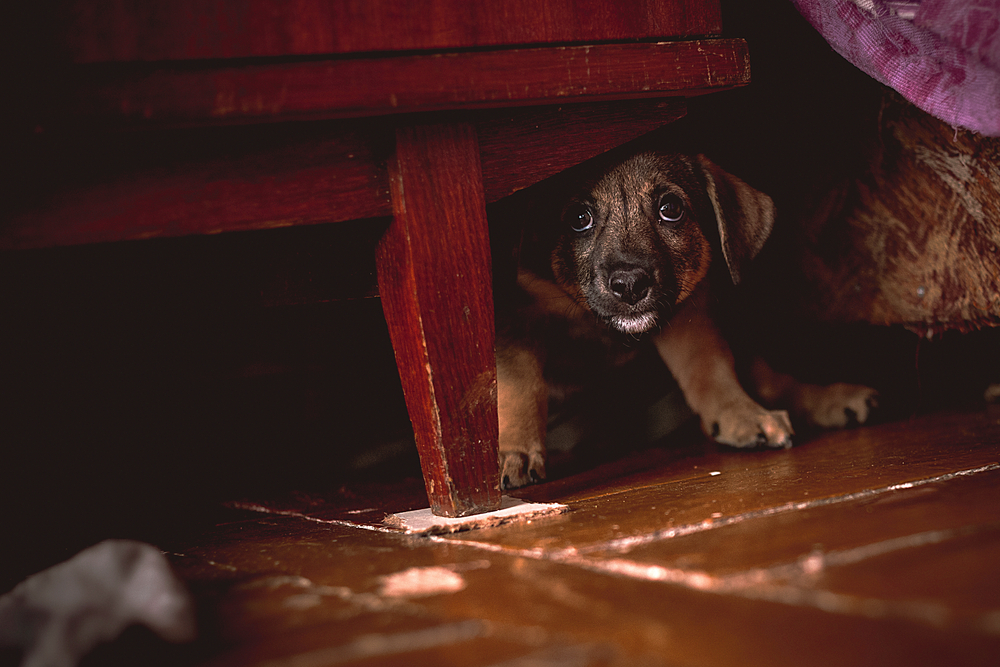Fireworks and thunderstorm season will soon descend on the Midwest. Around two-thirds of dogs have noise aversion (i.e., a condition that causes dogs to respond to certain noise triggers with anxiety or panic), yet most pet owners do not realize that mild noise aversion will likely progress or that treatments can help. The Greenfield Veterinary Clinic shares information and strategies to identify noise aversion and prepare your dog for the noisy summer season.
Identifying noise aversion
Statistically speaking, chances are high that your dog suffers from some degree of noise aversion, although signs can be subtle and difficult for pet owners to recognize. Some pet owners see their pet’s anxiety, but assume they will recover without assistance or with comfort. True noise aversion creates a panic-attack-like response in your pet’s brain that makes thinking or behaving normally difficult.
Noise aversion signs range widely between pets, but are usually predictable after specific noise triggers, and may continue for minutes or hours after the event. Possible signs include the following:
- Lip-licking or excessive yawning
- Panting
- Drooling
- Trembling, cowering, hiding, or clinging to people
- Attempts to escape
- Refusal to eat or take treats
- Hypervigilance
- Destruction of the home
- Vocalization
The impact of untreated noise aversion on dogs
When they first notice a problem, most people assume their pet will simply become accustomed to the noise and their anxiety will improve over time. In fact, noise aversion almost always worsens as trigger exposures continue. Noise-averse dogs may also develop additional triggers that cause more anxiety and panic, and can decrease their quality of life, and owners can be frustrated about their pet’s behavior, which can damage strong bonds.
Studies show that noise aversion not only worsens as pets age, but also is associated with other anxiety conditions. Eighty-eight percent of noise-averse dogs also have separation anxiety, which contributes to decreased quality of life. Pets require treatment to help alleviate their anxiety and to prevent them from losing their homes over behavioral concerns.
Helping dogs cope with noise aversion
If your dog has recently developed noise aversion or shows only mild signs, you may find success with household management and over-the-counter anxiety-reducing products. More severe or long-standing cases usually require pharmaceutical intervention. During a noise event, try the following to calm your pet:
- Provide a safe space — Many dogs like to hide or retreat to an interior room that helps block out common outdoor triggers, such as storms, fireworks, cars backfiring, lawn equipment, or construction sounds. Place comfortable bedding and familiar toys in the area your pet naturally chooses to hide to encourage them to stay where they feel safest.
- Play music — Calming classical tunes can drown out other noise and refocus your dog.
- Spray pheromones — Synthetic pheromones reproduce the calming signals that mothers send their puppies and may reduce some dogs’ stress.
- Place an anxiety wrap or cap — A ThunderShirt, calming cap, or similar strategies feel like a soothing hug without a person intruding in the dog’s space, which not every dog appreciates.
- Set a calm example — Follow your dog’s lead and let them choose their spot during a noise event and whether they want to be touched and petted. Otherwise, go about your normal business and act like nothing out of the ordinary is happening. Speak to your dog in a calm, regular tone, and avoid frantic attempts to soothe them—saying “It’s OK! It’s OK!” won’t help if your dog senses panic in your voice.
Long-term treatment strategies for noise aversion
The training and behavioral modification technique known as desensitization and counterconditioning may reduce your dog’s noise aversion reaction. This strategy introduces recorded noises at low intensities and volumes that do not cause reactivity and pairs them with a reward, such as a treat, to change the dog’s emotional response to the trigger. The volume is slowly and gradually increased until the dog no longer responds with fear. Not every dog responds to this strategy, because recorded noises cannot completely reproduce the real thing, but some may be helped.
When to seek extra help for noise-averse dogs

Pharmaceuticals are typically required for dogs with moderate to severe noise aversion. Our veterinary team can prescribe situational anti-anxiety or sedative medications that reduce your pet’s stress level during a noise event, and may make other calming strategies more effective. Dogs with many triggers may benefit from daily anti-anxiety medications that lower their anxiety threshold and help them respond better to desensitization and counterconditioning.
Left untreated, noise aversion can decrease your pet’s quality of life. Help them relax by seeking noise-aversion treatment from the Greenfield Veterinary Clinic team. Contact us to schedule a visit and behavioral consultation, or to discuss how a veterinary behaviorist or professional trainer referral may help your pet.







Leave A Comment